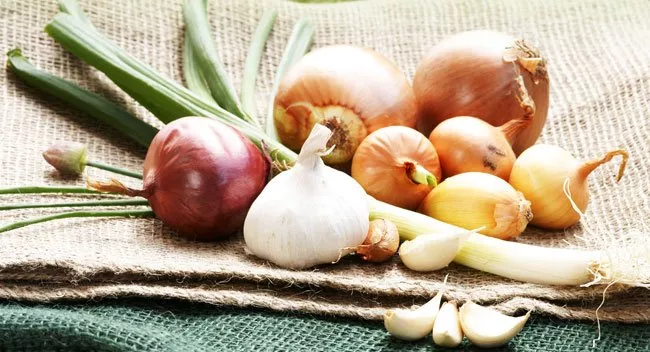Onions are not always the same. There are many different types of onions, of which there are different variants. We have presented the most common ones to you here.

The individual types of onions differ not only in their appearance, but also in their taste. In this way, you can also draw from a wide range of flavors and degrees of sharpness in the kitchen and prepare a wide variety of dishes.
The most well-known types of onions at a glance
Onions (Allium cepa)

The onion is the most common and is often also referred to as the onion. Garden onions, vegetable onions and spring onions also belong to this variety. A larger version of the onion are the vegetable onions, which are excellent for filling.
Onions in gardens
Onions are also popular for growing in domestic gardens. They are sown in the spring and can then be harvested between August and October. You can also plant small onion sets and then harvest the onions the following year.
Appearance of the onion
The onion usually has a brownish skin. However, there are also some with a red or white skin, which then also have a slightly different aroma. The sharpness can also vary here.
Using the Onion
You can use the onion either raw or cooked/fried. The onion not only gives numerous dishes a good taste, it is even an old household remedy.
Pearl Onion (Allium ampeloprasum)

Pearl onions are among the smallest types of onions, because they are just as big as hazelnuts. First and foremost, you know the small pickled pearl onions in jars that you can buy in stores. For a long time it has not had the same importance in the home kitchen as the normal kitchen onions or many other types of onions. From a botanical point of view, pearl onions do not belong to the onions, but to the leek family.
Pearl Onions in the Garden
You canPlant pearl onions well in the garden. The small onions are planted in the ground in autumn, and they are ready to be harvested next summer. Pearl onions cannot be stored as long as normal onions. They are more intended for early consumption. This is also the reason why you can hardly buy fresh pearl onions in the shops.
Prepare the pearl onions
Since the onions are so small, it is a bit difficult to peel them. It is best to simply scald them with hot water beforehand. The finely chopped pearl onions are best suited for the preparation of salads or soups. In contrast to other onions, pearl onions are less spicy, so you can eat them raw.
Shallot (Allium cepa var. aggregateum, Syn. Allium ascalonium)

The shallot is also suitable for the garden and is even ideal for beginners when it comes to cultivation. The shallot is one of the very robust vegetables and the harvest yield is quite large. Many people also prefer the flavor of the shallot, which is spicy and aromatic but not as hot as other varieties. They are smaller than the onions and have a slightly elongated shape.
Growing shallots in the garden
Shallots are planted in spring and can already be harvested in summer. The shallots are just as suitable for storage as the onions, they can even be stored outdoors for a few months.
Preparing shallots
Shallots are not ideal for sautéing because they can get a very bitter taste. Shallots are ideal for preparing salads or steamed in soups.
The selection of shallots on the market is small, but there are many different varieties. Shallots have an anti-inflammatory effect, which is why they also play a role in natural medicine.
Silver onions (Allium cepa var. cepa)

Silver onions in the garden
It is hardly suitable for growing in the garden as it does not have a protective skin and this often causes difficulties.
Use of the silver onions
In the trade, the silver onions are basically only offered in jars. The silver onion looks very similar to the pearl onion, but it belongs to a different family. The onions are suitable for eating raw as well as for decorating various dishes, on toast and with meat and vegetables.
Winter Onion (Allium fistulosum)

TheWinter onions are better known to us as spring or spring onions. Visually, this variety is more reminiscent of leeks.
Winter onions in the garden
Winter onions are mostly cultivated in climatic regions where conventional onions do not thrive well. The condition of the soil can also be a decision when growing. Winter onions are planted in autumn, the plants do not mind the frost in winter. Therefore, the planting can also be done quite late in the year. A few months later, in spring, the winter onions are ready for harvest.
Appearance of the winter onion
The winter onion has hollow, green, long stems, at the lower end it has a white bulge with fine roots. The look is very different from that of the other types of onions, but the spring onion still has the same ingredients as the conventional kitchen onion. All parts of the winter onion can be used in the kitchen, just cut off the lower end with the roots.
Use of winter onions
The green stalks are often used as a spice because they have a very intense aroma. You can use them either raw or cooked. Winter onions are stored in the refrigerator, where they will keep for up to a week. The winter onion is also used in medicine, it acts as a natural antibiotic, can reduce fever and fight inflammation.